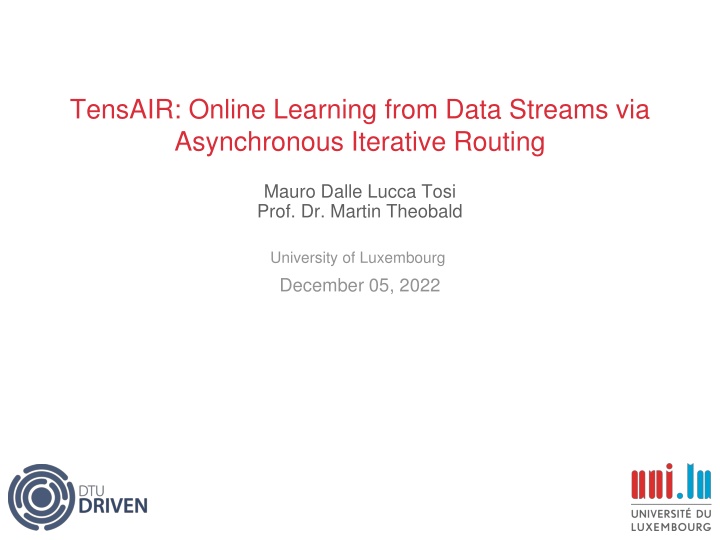
Asynchronous Online Learning Framework TensAIR
"Explore TensAIR, an innovative framework for online learning from data streams using asynchronous iterative routing. Learn about its features, characteristics, and experimental results in training neural networks. Discover how TensAIR enables decentralized and asynchronous TensorFlow processing, overcoming limitations of traditional solutions."
Download Presentation

Please find below an Image/Link to download the presentation.
The content on the website is provided AS IS for your information and personal use only. It may not be sold, licensed, or shared on other websites without obtaining consent from the author. If you encounter any issues during the download, it is possible that the publisher has removed the file from their server.
You are allowed to download the files provided on this website for personal or commercial use, subject to the condition that they are used lawfully. All files are the property of their respective owners.
The content on the website is provided AS IS for your information and personal use only. It may not be sold, licensed, or shared on other websites without obtaining consent from the author.
E N D
Presentation Transcript
TensAIR: Online Learning from Data Streams via Asynchronous Iterative Routing Mauro Dalle Lucca Tosi Prof. Dr. Martin Theobald University of Luxembourg December 05, 2022
Index 1. Background: Online Learning 2. Current solutions to train NN from data-streams 3. TensAIR 4. Experiments & Results 5. Summary 6. Demo 2
1. Background Online Learning Characteristics - Data streams - Time-sensitive - Simple Solutions - Concept Drift Streaming Processing Frameworks: - Apache Spark - Apache Flink - Apache Kafka - AIR 3
1. Background Distributed Asynchronous message passing Decentralised Figure 3: ST values (in 106events/sec.) of AIR, Spark and Flink over multiple nodes: SWA, YSB and YSB* [1] High-Performance (up to 36.58 Gb/s on 8 nodes and 224 cores) [1] V. E. Venugopal, M. Theobald, S. Chaychi, and A. Tawakuli, AIR: A light-weight yet high-performance dataflow engine based on asynchronous iterative routing, in 2020 IEEE 32nd International Symposium on Computer Architecture and High Performance Computing (SBACPAD), 2020, pp. 51 58 4
2. Current solutions to train NN from data streams Current Solutions: dl-on-flink Kafka and Tensorflow-IO TensorFlowOnSpark Limitations: Rely on the availability of the whole training data at once. Decreased performance under OL setting (real-time training). 5
3. TensAIR TensAIR is a framework that implements TensorFlow in an AIR Dataflow. C++ MPI Distributed, asynchronous, and decentralized Tensorflow C API Tensorflow models imported from Python 6
3. TensAIR: Figure 4: TensAIR general usecase dataflow. 7
3. TensAIR: Special Characteristics: Asynchronous Decentralized Convergence considerations: Training is performed between significant concept drifts. Theoretical convergence: Stale-Synchronous Parallellism (SSP). Practical convergence: not impacted by asynchronous training. 8
4. Experiments & Results: Problem Dataset Characteristic Word2Vec 1% English Wikipidea Sparse Image classification CIFAR-10 Dense Table 3: Problems characteristics. ULHPC Nodes Up to 16 Ranks per node (on CPU) 4 CPUs per node 28 GPUs per node 4 Ranks per GPU 1 Table 4: ULHPC configuration. 9
4. Experiments & Results: Figure 6: Convergence Analysis of TensAIR on the Word2Vec and CIFAR-10 usecases. Figure 7: Speedup Analysis of TensAIR on the Word2Vec and CIFAR-10 usecases. 10
4. Experiments & Results: Figure 8: Throughput comparison between TensAIR, TensorFlow, and Horovod. 11
5. Summary TensAIR: - Real-time train from multiple data-streams simultaneously. - Train NN models using CPUs, GPUs, or both. - Asynchronous and decentralized training. - Incorporate users pre and pos-defined pipelines. Future works: - Implement active drift detection strategy. - Investigate convergence guarantees for decentralized ASGD. - Audio / Video usecases. 12
6. Demo 13
7. Acknowledgement The Doctoral Training Unit Data-driven computational modelling and applications (DRIVEN) is funded by the Luxembourg National Research Fund under the PRIDE programme (PRIDE17/12252781). https://driven.uni.lu 14
Thank you! Gitlab: https://gitlab.uni.lu/mdalle/TensAIR TensAIR dataflow. 15






















